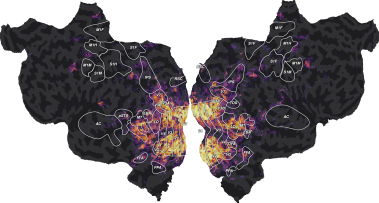Download the data set#
In this script, we download the data set from Wasabi or GIN. No account is required.
Note
This script will download approximately 2GB of data.
Cite this data set#
This tutorial is based on publicly available data published on GIN. If you publish any work using this data set, please cite the original publication [Huth et al., 2012], and the data set [Huth et al., 2022].
Download#
# path of the data directory
from voxelwise_tutorials.io import get_data_home
directory = get_data_home(dataset="shortclips")
print(directory)
/home/jlg/mvdoc/voxelwise_tutorials_data/shortclips
We will only use the first subject in this tutorial, but you can run the same
analysis on the four other subjects. Uncomment the lines in DATAFILES to
download more subjects.
We also skip the stimuli files, since the dataset provides two preprocessed feature spaces to fit voxelwise encoding models without requiring the original stimuli.
from voxelwise_tutorials.io import download_datalad
DATAFILES = [
"features/motion_energy.hdf",
"features/wordnet.hdf",
"mappers/S01_mappers.hdf",
# "mappers/S02_mappers.hdf",
# "mappers/S03_mappers.hdf",
# "mappers/S04_mappers.hdf",
# "mappers/S05_mappers.hdf",
"responses/S01_responses.hdf",
# "responses/S02_responses.hdf",
# "responses/S03_responses.hdf",
# "responses/S04_responses.hdf",
# "responses/S05_responses.hdf",
# "stimuli/test.hdf",
# "stimuli/train_00.hdf",
# "stimuli/train_01.hdf",
# "stimuli/train_02.hdf",
# "stimuli/train_03.hdf",
# "stimuli/train_04.hdf",
# "stimuli/train_05.hdf",
# "stimuli/train_06.hdf",
# "stimuli/train_07.hdf",
# "stimuli/train_08.hdf",
# "stimuli/train_09.hdf",
# "stimuli/train_10.hdf",
# "stimuli/train_11.hdf",
]
source = "https://gin.g-node.org/gallantlab/shortclips"
for datafile in DATAFILES:
local_filename = download_datalad(datafile, destination=directory,
source=source)
References#
A. G. Huth, S. Nishimoto, A. T. Vu, T. Dupré la Tour, and J. L. Gallant. Gallant lab natural short clips 3t fMRI data. 2022. doi:10.12751/g-node.vy1zjd.
A. G. Huth, S. Nishimoto, A. T. Vu, and J. L. Gallant. A continuous semantic space describes the representation of thousands of object and action categories across the human brain. Neuron, 76(6):1210–1224, 2012.
